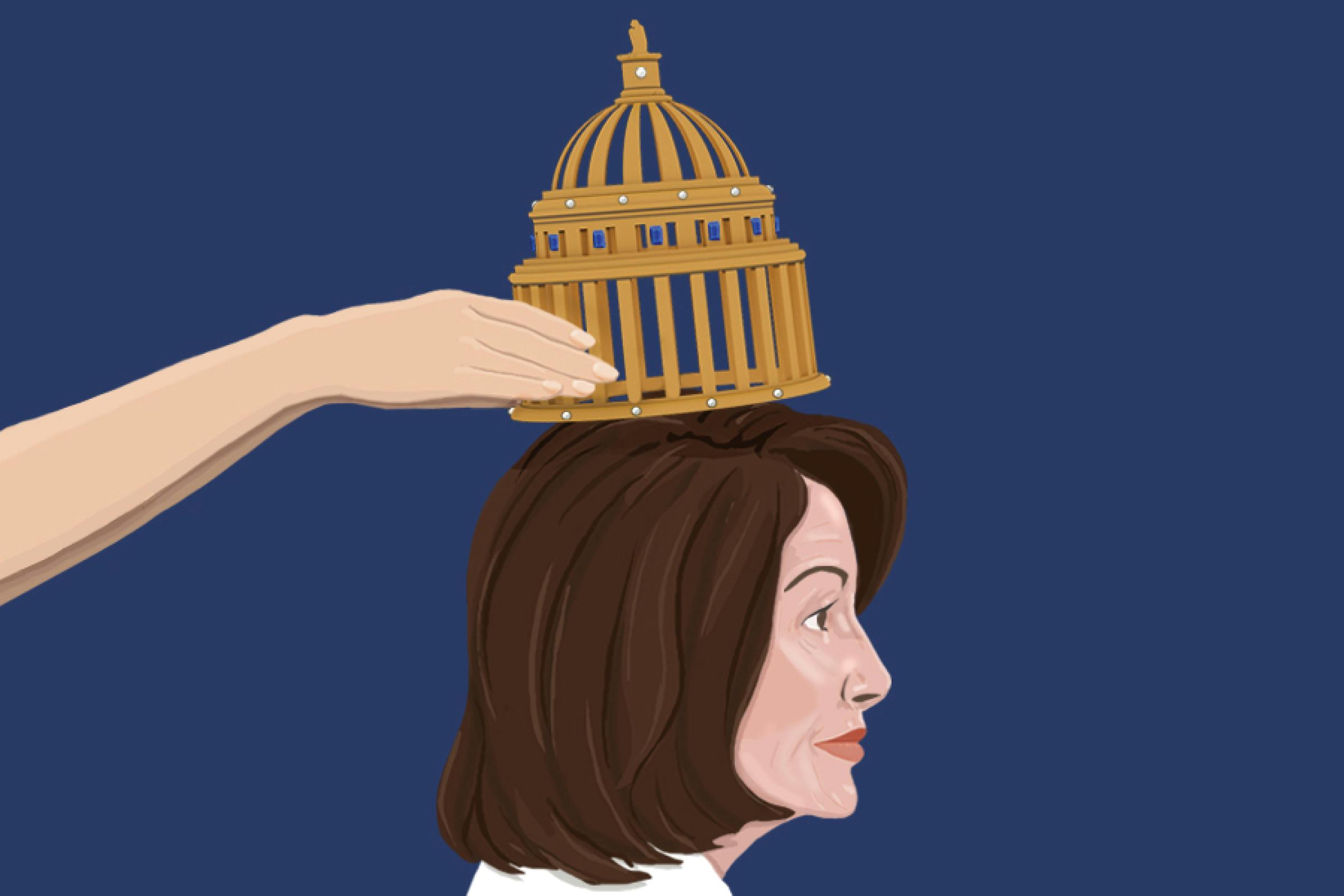
CNN journalist Brooke Baldwin struggled to describe what she was seeing from a helicopter flying over Mexico Beach on Thursday. “It’s gone,” she said. “It’s gone.”
Scenes of devastation from the Florida town have become the visual marker of Hurricane Michael, the third-strongest hurricane to ever hit the United States. With wind speeds of up to 155 miles per hour and a nine-foot storm surge, Michael essentially flattened Mexico Beach, leaving behind mountains of trash and two-by-fours. As of Sunday, search-and-rescue teams were still combing through the rubble there, and at least 46 people remained unaccounted for. Mexico Beach’s entire population is only about 1,200; around 280 people stayed to ride out the storm.
There is still hope for the 46 missing. Only one death has been confirmed in the town so far, leaving officials to believe that many who decided to stay may have fled at the last minute as Michael rapidly intensified. Still, when President Donald Trump visits Mexico Beach on Monday, he will find an American community effectively destroyed—similar to what Hurricane Katrina did to parts of New Orleans over a decade ago. And like New Orleans after Katrina, the future of Mexico Beach now rests on Americans’ resolve to rebuild what was lost.
But do most Americans know what was lost in the first place?
 View of the damage caused by Hurricane Michael in Mexico Beach on October 13, three days after Hurricane Michael hit the area.Hector Retamal/AFP/Getty Images
View of the damage caused by Hurricane Michael in Mexico Beach on October 13, three days after Hurricane Michael hit the area.Hector Retamal/AFP/Getty ImagesLindsey Yeargin doesn’t think they do, and she worries that the public’s unfamiliarity with Mexico Beach might prevent a large-scale rebuilding of the town she’s spent summers and holidays in since she was a child. “Anytime I tell anyone I’m going to Mexico Beach, people are like, where? You’re going to Mexico?” The town isn’t widely known in part because it’s small, Yeargin said; but it’s also because residents and longtime visitors have intentionally tried to keep Mexico Beach a bit of a secret from the world. “We want it to remain unspoiled.”
Mexico Beach is exactly that, at least compared to the overdevelopment that has plagued both Florida and the Southeastern United States as a whole. Despite warnings from climate scientists about rising seas and stronger storms, state and local officials have allowed real estate developers to line the Sunshine State’s shorelines with high-rises. They’ve built entire communities on swampy marshlands, effectively packing people into the areas most vulnerable to disaster.
Not so in Mexico Beach. Marked by a five-mile stretch of pristine white sand shoreline, the town is a prime location for a high-volume beach tourism economy like Panama City, just a half-hour drive away. But officials have long resisted the temptation. There are no high-rise buildings; the city’s land use plan bans the construction of new buildings over five stories high. At least one mile of public beach must always be free of development, according to Vie Magazine. There are no traffic lights in the city. And nearly all the businesses are family-owned. “There was a Subway—that was the one franchise eatery in town,” resident Lebron Lackey told The New York Times, implying that after Hurricane Michael, there are no franchise eateries in town.
 Homes and businesses are left in devastation by Hurricane Michael on October 12, 2018 in Mexico Beach, Florida. Mark Wallheiser/Getty Images
Homes and businesses are left in devastation by Hurricane Michael on October 12, 2018 in Mexico Beach, Florida. Mark Wallheiser/Getty ImagesVisiting Mexico Beach thus felt like stepping back in time. “You feel like you’re actually making an escape from the real world when you go there,” said Yeargin, who lives full-time in Atlanta, Georgia. “It’s a special part of the United States, seemingly untouched by a lot of the corporate greed that’s going on, the overdevelopment that’s going on.”
But the old-time feeling of Mexico Beach has proved a double-edged sword. Because the city never gave in to overdevelopment, it also never fortified its old buildings to withstand the stronger storms of a warmer world. In 2007, the county implemented regulations requiring new construction to be able to withstand hurricane-force winds of 120 to 150 miles an hour, according to the Times. But old structures, like the majority of those in Mexico Beach, were allowed to remain.
Much of that old construction is now gone. If the families and business-owners want to rebuild, they’ll have to do it in compliance with the latest regulations. This worries Yeargin, since the new building code requirements are expensive, and most of Mexico Beach is working class. “I worry that these local places maybe don’t have the money or the resolve to rebuild,” she said. “I hope they do. I hope they get as much help as they need.”
Residents are certainly determined. “We will definitely have the same views, the same sunsets and the same address,” local homeowner Rick Moore told the Tallahassee Democrat. Yeargin said she’s circulating GoFundMe pages for affected families, and plans to start volunteering at rebuilding projects in November. Those projects could be bigger, smaller, or maybe just stronger—Yeargin isn’t sure. But she’s sure of one thing about Mexico Beach: “It won’t ever be the same.”

At a San Francisco gala to raise money to fight climate change in September, Nancy Pelosi ran into Jane Goodall, the famed primatologist, and snapped a selfie with her “dear friend,” as the House minority leader described her. Pelosi had had a hand in funding Goodall’s work years earlier. Before she went into politics, Pelosi was on the board of the Leakey Foundation, which has funded major scientific breakthroughs about human prehistory by Goodall and others. She remains an avid amateur paleontologist, and even went to Kenya on a dig with her children in 1989.
“Evolution, the way humans learned and changed over time, it’s amazing,” Pelosi told me recently. “You can learn so much.”
Her understanding of evolution has served her well in Washington, where politicians, like all primates, have to fight to survive, and the next generation tends to eat the last. But two years into the Trump administration, Pelosi, the once and potentially future House speaker, is no longer a predator. She’s prey.
The minority leader has spent almost her entire political life under threat. Conservatives have vilified her as a San Francisco wingnut who wants to drag America into socialized health care, weaken the military, and throw money around like confetti at a Pride parade in the Castro. (They often trot her out as the unwitting star of their attack ads, linking her to Democratic candidates all over the country.) At times, moderates in her own party have piled on. Last year, Tim Ryan, a centrist Democrat from Ohio, led an insurrection in which 63 members voted to remove her as minority leader. Now, however, Pelosi is under assault from a new cohort: the left politicians eager to distance themselves from an ossified Democratic establishment. Dozens have rushed to announce that they wouldn’t support her for speaker should they take back the House in November. “While I respect Leader Pelosi’s years of advocacy on behalf of California and the Democratic Party,” said Gil Cisneros, the Democratic nominee for a Los Angeles House seat and a self-described Bernie Sanders Democrat, “it’s time for new leadership.”
Democrats should be careful what they wish for. Pelosi’s longtime number two, and the person most likely to succeed her if she is pushed out, is Steny Hoyer, a moderate Blue Dog Democrat from Maryland. No matter how much left-wingers pillory Pelosi’s willingness to compromise with Republicans, and her ties to big donors, she is still a better fit than Hoyer for their agenda. She may not be a purist, a Democratic socialist, or even particularly charismatic. But she understands her party and the pressures it faces. Democrats can dismiss her as a relic, a fossil like those she was hoping to dig up in Kenya, but they may be surprised at how much of an asset she can be.
When Pelosi first entered House leadership as minority whip in 2001, her party was still full of Blue Dogs and Bill Clinton’s New Democrats. An early proponent of marriage equality and a champion of women and minorities within the Democratic ranks, Pelosi was decidedly left of center.
Republicans would go on to depose leader after leader: Majority Leader Eric Cantor fell to a Tea Party challenger; Speaker John Boehner was forced out in a rebellion engineered by the Freedom Caucus; and the current Speaker, Paul Ryan, is stepping down of his own accord, leading an exodus of more than 40 longtime GOP House members this fall (and essentially handing Democrats a shot at taking back the House). Meanwhile, Pelosi has consolidated her power.
 Steny Hoyer, Pelosi’s moderate heir apparent, appeared with Pelosi at a congressional committee hearing in 1997.Christopher Ayers/CQ Roll Call/Getty
Steny Hoyer, Pelosi’s moderate heir apparent, appeared with Pelosi at a congressional committee hearing in 1997.Christopher Ayers/CQ Roll Call/GettyMuch of her resiliency lies in her strength as a legislator. Unlike Boehner and Ryan, who were viewed as giving up too much ground to extremists within their own party, Pelosi has always kept recalcitrant members in line. “I think she was the most effective speaker in a very long time,” said Norm Ornstein, a scholar at the conservative American Enterprise Institute. “Tough, focused, and able to keep a caucus with wide variance in views and political pressures together.” Her deal with pro-life Democrats to push through Obamacare in 2010 remains one of the more masterful moments in recent political history. She got cap-and-trade passed in the House by winning over—unbelievably in retrospect—enough Republican votes for that climate change measure. (It would later fail in the Senate.) And she created the independent Office of Congressional Ethics, over strong GOP opposition and a lot of skepticism among Democrats, who would later see it used against members of their own party, including Charlie Rangel and Maxine Waters.
Most important—it’s Washington, after all—Pelosi is valuable because she is still the top fundraiser in Congress, Republican or Democrat. Forcing her out would mean replacing the more than $100 million she raises each cycle. Her fundraising skills are one of the key reasons she has been able to fend off threats as long as she has, despite how unpopular her ties to big donors have made her with some on the left.
Still, over the last two years, Pelosi’s grasp on power has grown more tenuous. “In the past, the challenges to [her] leadership have come from the more moderate members,” said Michele Swers, a government professor at Georgetown who has written several books on women in Congress. Even now, many moderate Democrats are running on promises to oppose her speakership if elected. Clarke Tucker, a Democratic candidate in Arkansas, has vehemently criticized Pelosi’s leadership. So has Conor Lamb, a Democrat who won a special House election in Pennsylvania earlier this year after distancing himself from Pelosi. “It’s clear that this Congress is not working for people,” Lamb said in January. “I think we need new leadership on both sides.” The difference now, Swers said, is that “she is also being challenged by more liberal members.”
The very things that make Pelosi such a capable leader have turned the insurgent left wing against her: the willingness to make deals, to thread a needle in a touchy political situation, to give others credit for her wins, and to draw moderate votes from the other side. Now, though, she has to contend with an unruly Democratic opposition no longer willing to be deferential to those in power—not just the man in the White House, but their own leadership.
Still, the chances of Pelosi’s being deposed remain relatively low. By some counts, more than four dozen incumbents and candidates have said they will vote against her. That’s not enough to oust her in a caucus vote—it would take a majority of Democrats, at least 110 votes, to do that. The threshold is different if someone were to engineer a vote on the House floor. Such a vote would include Republicans; and if Democrats win a narrow majority of 218 seats in November, and even a single Democrat defects on the House floor, it would sink her speakership. (The mere threat of such a vote succeeded in ousting Boehner in 2015.) The larger the win, of course, the more votes Pelosi can afford to lose, and this is shaping up to be a wave.
There’s also the question of whether the left really wants her out, no matter their rhetoric on the campaign trail. If Pelosi steps aside without a vote, as some have called on her to do, Hoyer will be gunning for the speakership in January. Perhaps as a result, left-wing candidates like New York’s Alexandria Ocasio-Cortez have been cautious about calling for Pelosi to resign. (Ocasio-Cortez has refused to say whether she’d vote for Pelosi as speaker and has even praised her leadership in the past.)
Furthermore, efforts to reduce the number of closed primaries and hyper gerrymandered districts—which produced the Tea Party in 2010—may lead to more moderates in Congress, particularly among Democrats. So it seems likely that the far left will remain a minority for the foreseeable future. And given the choice between Pelosi or Hoyer, those on the left would probably choose Pelosi: Her politics more closely align with their own.
Still, someday, someone will succeed her. Pelosi has lost many heirs apparent over the last decade—Rahm Emanuel to Obama’s White House, Chris Van Hollen to the Senate, and Xavier Becerra to California politics—all except Hoyer. If not him, her successor could be another politician whose career she’s helped foster, like New York’s Hakeem Jeffries or California’s Eric Swalwell. It might even be a woman. Pelosi has fought hard for female members, working to increase their ranks from just 20 percent of the caucus when she became minority leader in 2003 to 32 percent today. Their numbers are poised to increase if things go as expected in November. That fact, perhaps more than anything, undermines the idea that Pelosi is a political relic. She has been instrumental in helping the party evolve. And how many female legislators will want to kick the most powerful woman within their ranks out on the heels of the second Year of the Woman?
Ultimately, Democrats should avoid making the same mistakes the GOP did before them: Party unity is the key to survival. Or, they can take a lesson from Pelosi’s hobby, paleontology. Spend less time eating their own, and they might have a better shot at keeping control of Congress if they win in November.

It took twenty minutes to kill the Romanovs. So many bullets had been fired on Tsar Nicholas II, that the room filled up with smoke and the gunmen couldn’t see the rest of the family. The children—the Grand Duchesses Olga, Anastasia, Tatiana, Maria and the young Tsarevich Alexei—had diamonds sewed into their clothes that caused the bullets to ricochet. The firing squad instead tried to finish the survivors off with bayonets. They even shot the dogs, though one, a spaniel named Joy, escaped, and was found days later in the woods by a British soldier. Joy ended his days in comfort in England, and is buried by Windsor castle, a fitting end for the sole surviving member of the Russian royal family.
It is this gruesome scene of a family’s last moments in a Siberian basement that serves as the opening credits to Matthew Weiner’s highly anticipated new show The Romanoffs. The title might suggest a period drama, like Weiner’s last hit Mad Men. But The Romanoffs is set in the present-day and Weiner has likewise turned away from the serialized form to produce something more akin to an anthology. Each roughly 90-minute episode centers on a different character who claims to be a descendant of the Romanovs and the havoc they think this entitles them to wreak on the lives of others. “These characters,” Weiner explained to The Hollywood Reporter, “believe themselves to be, whether they are or not, descendants of this last autocratic family who are part of one of the great true crime stories of all time.”
This sense of being victims of a terrible injustice, a crime of epoch-making proportions, unites the characters in The Romanoffs far more than blood. Whether or not they are actually related to the Romanov family is immaterial. What matters is that they believe their lives are not what they should be, that they have somehow been robbed of their rightful place within an antiquated hierarchy, cheated of a grand inheritance, and unjustly deprived of their right to be xenophobic or power-hungry narcissists—without people judging them for it.
Nostalgia
for the Russian royal family often functions in The Romanoffs as a kind of status anxiety, a primal scream against egalitarianism
aired to the tune of Rimsky-Korsakov’s Scheherazade.
But Weiner’s interest in flawed human beings, which worked in the character-driven
Mad Men, threatens here to romanticize
autocracy. In order to examine a deluded longing for a bygone era, you have to
acknowledge the realities of that era—and the real story of the dynasty that
ruled over it, their obstinate cruelty and apathy in the face of mass suffering.
Much
like the opening pages of Tolstoy’s War
and Peace, the first episode’s dialogue is almost entirely in French. Set
in Paris, most of the drama revolves around the opulent apartment that belongs
to Anastasia “Anushka” LeCharnay (Marthe Keller), an impeccably dressed
chain-smoking woman with high blood pressure who claims to be a Romanov. She says
the apartment was purchased by her great great-grandfather, an illegitimate son
of Paul I (son of Catherine the Great) because “he liked to hear the sound of
the guillotine” (Anushka relishes in relaying anecdotes about the insensitivity
of her autocratic ancestors). Her American nephew Greg (Aaron Eckhart) and his
French girlfriend Sophie (Louise
Bourgoin) spend much of the
episode openly waiting for her to die so they can inherit the place and the
yellow fabergé egg that rests inside it.
Anushka is cruel and abusive to the caretakers Greg hires to look after her, and no one is able to last long until the agency sends along Hajar (Inès Melab), young Muslim woman studying to be a nurse. Anushka is at first loathe to let her into the apartment, screaming “Take your bombs and go home!” Despite strong performances from Kelly and Melab (Weiner’s talent for extracting haunting yet understated performances from his actors is a happy carry over from “Mad Men”), the premiere sadly slips into the movie trope of the racist who only becomes repentant after she runs out of slurs. Anushka’s growth on the question of migrants in France is meant to be marked by her telling Hajar (who was born in France and is not an immigrant, as she has to constantly remind everyone): “I am also an immigrant. I know what it is to be in exile. Every night—I dream of Russia.” Moments later, she admits she’s never been there.
Anastasia lets her Romanov legacy stand for different things at different times. At the beginning of the “Violet Hour,” Anastasia uses her supposed heritage to mark her identification with a dying European world order. Then it shifts, just as her feelings towards Hajar change: Being a Romanov suddenly means being a victim of unspeakable violence. Towards the end of the episode, Anastasia reveals a traumatic memory to Hajar of a time when the Nazis, believing her anti-Communist family would be sympathetic to them, occupied the Paris apartment and raped her sister.
Indeed, being a Romanov is more about how these characters make sense of and channel their own pain at the world. The actual history of the Romanov dynasty itself, as well as Russian history and culture more broadly, is represented onscreen largely in clichéd touches like Fabergé eggs, Tchaikovsky’s “Dance of the Sugar Plum Fairy,” and cartoonish representations of Rasputin. “Anushka” is also not the proper diminutive of Anastasia; it is a nickname for “Anna,” an entirely different name in Russian.
This is arguably where the show is at its most profound; it would seem to mock some of the worst tendencies of our current genealogy craze—think of the Ancestry.com commercial in which an American who realizes he’s of Irish extraction, not German like he thought, proudly proclaims “I turned in my lederhosen for a kilt!” Weiner rightly points out that these investments in heritage often say more about who we want to be than who we are.
The second episode of the series shifts from central Paris to a decidedly less glamorous suburban strip mall where Michael Romanoff (Corey Stoll) works as college entrance exam tutor. He and his wife Shelly, played by Kerry Bishé, are in couples counseling, but the source of their marital woes is somewhat vague. Shelly later admits her problem in the marriage “might be him.” Michael is certainly bored, but a new chance for excitement comes from a surprising place: jury duty.
Assigned to a murder trial, he falls for one of the other jurors, a seductive true crime lover played by Janet Montgomery. Trying to impress her, Michael mentions that his whole family was murdered by the Bolsheviks. With Michael preoccupied, Shelly decides to go by herself on a cruise she planned for both of them, a tour hosted by the “Romanov Family Society” of the Black Sea (or they may just be pretending to be on the Black Sea—it’s unclear). Once on board, she is somewhat ostracized by the others for being a Romanov only “by marriage.” She meets another “by marriage” Romanov (Noah Wyle) and the two outsiders try to make sense of why this legacy means so much to their spouses. “Who gives a shit?” Shelly wonders.
Shelly’s line reminded me of a scene in Season 1 of “Mad Men” when it is revealed by Donald Draper’s rival, Pete Campbell, that Don has been living under an assumed name. “Mr. Campbell,” their boss asks, “who cares?” Don, actually Dick Whitman, switched identities with the real Donald Draper, his army lieutenant in the Korean War who died on the battlefield. Don’s efforts to forge a new future through an invented past served as the fitting undercurrent of a show ostensibly about advertising but truly about consumerism’s promise of self-reinvention through acquisition. In this way The Romanoffs is a fitting follow-up for Weiner, but none of the characters use their new identities to become anyone half as interesting as Don. I found myself wishing I could watch the show within the show, “The Romanovs,” instead, or at least a better version of it.
“The Romanovs: A Mini-Series” appears in Episode 3, “A House for a Special Purpose.” Olivia Rogers (Christina Hendricks) arrives in Austria to star as Alexandra, wife of Nicholas II, when she encounters a tyrannical first-time director Jacqueline (Isabel Huppert) who will do whatever it takes to give her actors the right motivation, grabbing the actor who plays Nicholas II (Mike Doyle) by the testicles. Jacqueline, who claims to be a descendant of the Romanovs, uses that to enforce her will on the actors, telling Olivia “This is my family’s story. And you walk through it. It doesn’t mean anything to you.” (It’s hard to watch Jacqueline’s behavior and not think of Mad Men writer Kater Gordon’s allegations last year that Weiner sexually harassed her, or of the producer Marti Noxon’s judgment that Weiner was “an emotional terrorist.” Weiner has denied Gordon’s allegations, but has reflected “in a general sense” on his behavior in the workplace.)
But that “story,” in Jacqueline’s telling, consists of only the most well-known and sugarcoated plot points—nothing that a cursory watching of the 1997 animated film Anastasia, wouldn’t cover. Weiner surely realizes this, and yet the irony is never made explicit, and the show’s stance on all the big questions it gestures towards—of history, legacy, and family mythology—is never clear.
As a meditation on the misuse of history to justify feelings of resentment, The Romanoffs had the potential to be a resonant drama: It’s been a little over a year since the events of Charlottesville and a national conversation about the uses of our own past. Yet for a show so concerned with the way the past can be contorted to satisfy present-day egos, it curiously never delves into the actualities of the Romanov reign. Nicholas II exists onscreen only as a buffoonish cuckold, not as the absolute monarch who turned a blind eye to mass starvation, housing shortages, and the many miseries that marked life in the waning years of his rule. Don Draper had to come to terms with the effects of the cigarettes he had helped sell to the American consumer; hopefully the would-be Romanovs in Weiner’s new show will air their family’s dirty laundry in the remaining episodes.



No comments :
Post a Comment